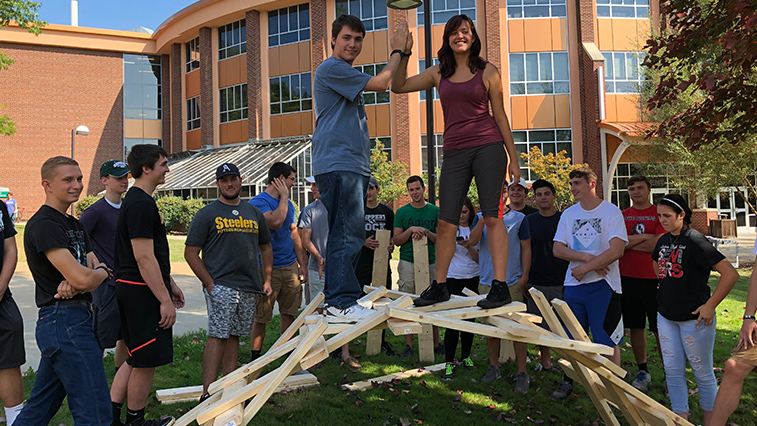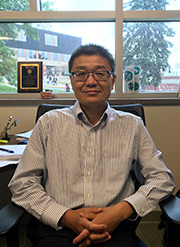FYRST Seminar helps “bridge” the gap for first-year SRU students

Kimberly Matsinger, a senior physics major who is a peer leader for Slippery Rock University's FYRST Seminar program, walks across a da Vinci Self-Supporting Bridge built by first-year students during a FYRST Seminar class project.
Oct. 18, 2017
SLIPPERY ROCK, Pa. - Leonardo da Vinci's Self-Supporting Bridge is an example of brilliant design. Constructing the bridge, however, is an example of what it takes for Slippery Rock University students to be successful.
First-year students at SRU are enrolled in a one-credit course called the FYRST Seminar, which is "designed to help bridge the transition between high school and college." With a few exceptions, SRU students are grouped by majors in FYRST classes that meet once a week for 70 minutes with a professor and an upperclassman peer leader. The students are introduced to concepts in their major and general programs and services at the University.
For students in the physics and engineering department, they got more than the typical guest speaker or demonstration on using campus technology. They got to build a bridge.
Provided 30 pieces of lumber, mostly two-by-sixes, and no ropes or nails, the FYRST class was tasked by professor Xinchao "Steven" Wei with building two small arch bridges and one large bridge using a design made famous by da Vinci in the late 15th century.
"The power of engineering is that part of it is design; we know it works," said Wei, professor of physics and engineering and engineering program director. "But the implementation and teamwork has to be as good as the design."
The students worked together, breaking up the tasks as lifters, spotters and runners. They had to distribute the forces of the lumber to make sure everything was centered and symmetric, or else the three-foot high bridge would collapse.
"The students learned how to the work together and that even the small jobs that don't seem important really are," said Kimberly Matsinger, a senior physics major from West Chester, who serves as a FYRST peer leader. "Everyone liked the hands-on part of the class. A lot of times we have speakers who provide a lot of knowledge but it's not always fun. This was very fun and got the entire class working together."
"In the engineering professions it's not likely that you'll work by yourself," Wei said. "I asked, 'What did you learn?' They didn't mention the design. They mentioned teamwork."

WEI
Matsinger was one of the first to walk across the large bridge after it was built. Another student joined her. As more weight was added, the bridge became more stable because the load provided friction. Only after everyone stepped off did the bridge collapse.
The bridge metaphor can be applied beyond the transition from high school to college for FYRST Seminar students. The curriculum at the University could be designed perfectly, but student success takes the right implementation and teamwork.
Matsinger unintentionally made the comparison by describing her role as "a bridge between students and faculty," saying that first-year students are sometimes afraid to pursue their professors for help.
"It's (FYRST) a great benefit for exposing the freshmen to different offices and programs," said Matsinger, who added that through FYRST she learned how to register for the right classes when she was a freshman. "Just getting students involved is very important early on. If I didn't have this course, I would've been very lost."
The FYRST Seminar is now its 18th year at SRU. More than 60 faculty members teach sections of the seminar each fall semester and approximately 95 percent of all first-year students whose departments participate in the FYRST program are enrolled.
"The main focus is to help students make a good transition to the University and be successful in all aspects of their academic careers here," said Cathy Brinjak, assistant professor of academic services and director of the FYRST Seminar program. "For many students, it's the first time they are away from home and the first weeks of the semester can be really tough, but we help them learn how to transition for not only academic success, but personal and behavioral success as well."
And like the da Vinci bridge, the more people bearing the load together on the bridge to success, the more stable it becomes.
MEDIA CONTACT: Justin Zackal | 724.738.4854 | justin.zackal@sru.edu

